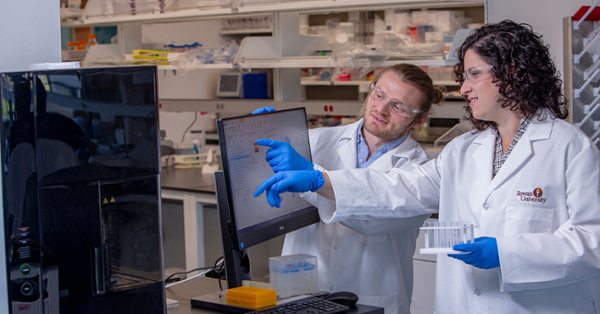Could nanoparticles lead to new treatments for pregnancy complications?
Could nanoparticles lead to new treatments for pregnancy complications?

Preeclampsia and related hypertensive disorders of pregnancy affect 5-8% of births in the United States, according to the nonprofit Preeclampsia Foundation. These are potentially dangerous conditions in which maternal blood pressure rapidly rises, along with other symptoms and severe disease can lead to seizure, stroke, multiple organ failure and death of the mother and/or fetus. The only curative treatment for severe disease is to induce preterm birth, which can have detrimental short- and long-term effects for the infant.
Over the last two decades, the rate of preeclampsia in the United States has risen 25 percent, contributing to worsening maternal and infant mortality rates. Rachel Riley, Ph.D., an assistant professor of biomedical engineering in the Henry M. Rowan College of Engineering and the Rowan-Virtua School of Translational Biomedical Engineering & Sciences, is pursuing new ways to study and treat preeclampsia and other diseases of pregnancy using nanoparticles—very tiny spheres that can be used to deliver nucleic acids or therapeutic drugs to specific tissues. According to Dr. Mary Staehle, interim head of the Department of Biomedical Engineering, Riley’s work “is at the cutting edge of engineering and translational medicine, with great potential in women’s health.”
Riley received the 2024 Peter Joseph Pappas Research Grant from the Preeclampsia Foundation at the Society for Maternal Fetal Medicine 44th Annual Pregnancy Meeting for her project, “Elucidating the Mechanisms of Immune Dysregulation in the Pathophysiology of Preeclampsia using Nanotechnology.” The $99,997 grant will support work to develop nanoparticles that target specialized cells in the placenta, an organ that forms in the womb during pregnancy to transfer oxygen and nutrients to the growing fetus through the umbilical cord.
“In preeclampsia, which is the most common disease of pregnancy, the placenta undergoes abnormal development early in gestation,” Riley said. “We aim to develop nanoparticles to deliver drugs to the placenta to regulate placenta function in support of healthy pregnancy.”
In preeclampsia, blood flow through the placenta is restricted, leading to high blood pressure in the mother and potentially restricted growth in the fetus. This funded project is led by Riley, along with Samuel Hofbauer, an M.D./Ph.D. trainee in her lab, to understand preeclampsia pathology and to develop therapies to safely extend pregnancy and improve outcomes.
“If we can understand why preeclampsia develops,” said Riley, “we can treat it earlier with better outcomes for pregnant people and their infants.”